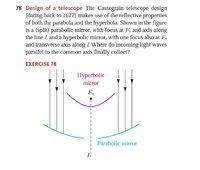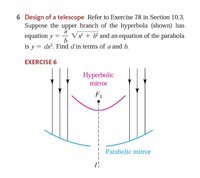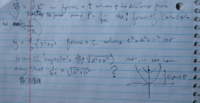allegansveritatem
Full Member
- Joined
- Jan 10, 2018
- Messages
- 962
You haven't shown the entire picture, or stated how the hyperbola and parabola are to be related; certainly you are not being asked to find d in terms of where they intersect, as you seem to be doing.Here is problem:
View attachment 28112
View attachment 28113
The exercise referred to (62 in section 10.3) basically just describes a Cassegrain telescope configuration and asks how it works.
Here is the only way I could come up to work this out:
View attachment 28114
Sad, I know, but I couldn't find a way to translate the x into a or b or a combination of both.
yes, the parabola and the branch of a hyperbola have mirrored surfaces that face each other and both share a focus. I will have to go over your post later when I work on these things. I'm not sure what you're saying but I will sift out your meaning. ThanksYou haven't shown the entire picture, or stated how the hyperbola and parabola are to be related; certainly you are not being asked to find d in terms of where they intersect, as you seem to be doing.
I suspect that they are to have the same focus. What is the focus of each curve, based on the given equations? Note that the vertex of the parabola is at the origin, which is the center of the hyperbola. Then you can set the foci equal, and solve for d.
Thanks, I can use this.
Precalculus;Functions&Graphs12e2012EarlSwokowski&JefferyColeHere is problem:
View attachment 28112
View attachment 28113
The exercise referred to (62 in section 10.3) basically just describes a Cassegrain telescope configuration and asks how it works.
Here is the only way I could come up to work this out:
View attachment 28114
Sad, I know, but I couldn't find a way to translate the x into a or b or a combination of both.


Creative googling - well done!Precalculus;Functions&Graphs12e2012EarlSwokowski&JefferyCole
I came to the same conclusion today...but....I will have to read over you post and digest it. Thanks.Beer induced opinion follows.
Precalculus;Functions&Graphs12e2012EarlSwokowski&JefferyCole
Section 10.3 #78
View attachment 28121
Precalculus;Functions&Graphs12e2012EarlSwokowski&JefferyCole
Chapter 10 DISCUSSION EXERCISES #6
View attachment 28120
The Standard Form of the Equation of a Hyperbola with Center at the Origin whose
Transverse Axis is on the y-Axis is given by
`(y-k)^2/a^2-(x-h)^2/b^2=1`
If the upper branch equation of the hyperbola as shown is `y=a/b*sqrt(x^2+b^2)`
then it follows that its center is at `(h, k) = (0, 0)`.
The corresponding upper focus is then at `(h, k+c)` where `c=sqrt(a^2+b^2)`
The Standard Form of the Equation of a Parabola whose Axis of Symmetry Is the y-Axis is given by
`(x-h)^2=4p(y-k)` or `(y-k)=(x-h)^2/(4p)` or `y=1/(4p)*x^2` since they (hyperbola and parabola) share a common upper focus (and the parabola's vertex must also be at the origin) where `p>0` and the focus is at `(h, k+p)`.
Thus, `d=1/(4p)`.
I leave you to do the final substitution.
I worked on this for a couple of hours today. I reviewed both figures, parabola and hyperbola and what I was able to come up with is this:You haven't shown the entire picture, or stated how the hyperbola and parabola are to be related; certainly you are not being asked to find d in terms of where they intersect, as you seem to be doing.
I suspect that they are to have the same focus. What is the focus of each curve, based on the given equations? Note that the vertex of the parabola is at the origin, which is the center of the hyperbola. Then you can set the foci equal, and solve for d.

Where is d in your work??? That's what you're supposed to solve for. You seem to have changed it to "a".I worked on this for a couple of hours today. I reviewed both figures, parabola and hyperbola and what I was able to come up with is this:
View attachment 28135
So...I set the y factors of either focus to equal and came up with what seems like an impossibility. I feel that I am missing some crucial concept that will relate these figures...
I don't think I've thought this exercise through. I can draw the cassegrain set up...but where does d go? Is d the directrix of the parabola? If so, it should be y = negative something...and if d is the directrix then my answer has to be d = -p and p is 1/4a...so who needs b in any of this? Well I will go back to it today and see if I can actually think it through a little better.Where is d in your work??? That's what you're supposed to solve for. You seem to have changed it to "a".
I have copied your post and will go over it later today when I work on this problem again. It looks at first glance like it might help me get out of the wilderness. ThanksView attachment 28136
Your parabola is [MATH]x^2=\dfrac{1}{d}y[/MATH]So your focus is [MATH](0,\dfrac{1}{4d})[/MATH]
Therefore you have (or should have), [MATH]\dfrac{1}{4d}=\sqrt{a^2+b^2}[/MATH]What is d=?
I was thinking about that "a" at 3 AM-I am periodically an insomniac in my old age-and discovered that the a meant one thing in relation to the hyperbola and something else, or some other quantity--for the parabola. Thus, p in the parabola is not = to the a in the formula y=ax2. Is this what you mean by "dangerous"?There's a major problem here: "a" is already defined in the problem, so you can't say "d = a". What you mean is right (that you are relating d in the problem to "a" in a formula you were given), but it's really dangerous to write this way.
Otherwise, good work.
You are right. Thanks. It makes better sense that way.Yes. I think I would replace the first line with: [MATH]y=dx^2 \rightarrow d=\frac{1}{4p}[/MATH]Then everything is grand!
It's not primarily about p; it's that a, b, and d are all defined in the formula, so you can't use a to mean the coefficient of x^2 in the parabola.I was thinking about that "a" at 3 AM-I am periodically an insomniac in my old age-and discovered that the a meant one thing in relation to the hyperbola and something else, or some other quantity--for the parabola. Thus, p in the parabola is not = to the a in the formula y=ax2. Is this what you mean by "dangerous"?
Good. ThanksIt's not primarily about p; it's that a, b, and d are all defined in the formula, so you can't use a to mean the coefficient of x^2 in the parabola.
All you needed to say was d = 1/(4p), where p is the focal length of the parabola (which wasn't previously defined, so you need to say what it means).
